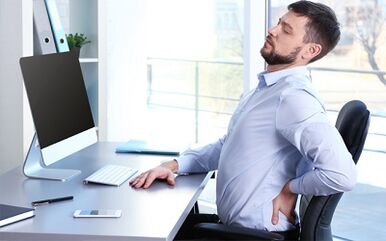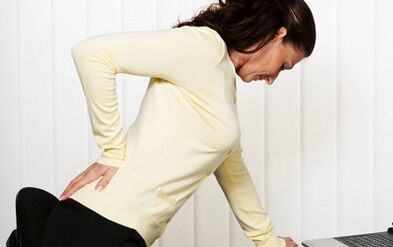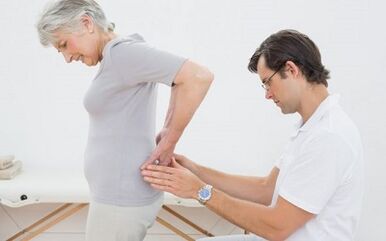
Acute pain in the lumbar region, in the context of spine osteochondralism, is a widely used problem facing the vast majority of people.Get us "as a reward" for our simple state (due to the increase in the axial load on the spine), this disease sooner or later affects every inhabitant of the planet, the only question is how fast this happens and how the symptoms are expressed.Such statistics "Lean" force this pathology to socially important diseases, and the struggle against him should be a duty not only for a person suffering from manifestations of the disease, but also the global health system as a whole.Therefore, the issue of the treatment of spine osteochondal is a very important issue.
So what is osteochondria?Consider briefly how the development of the disease happens.In its name, if you translate it from Latin literally, the structures that change with osteochondria are identified: bones and cartilage.In order to underestimate and resist vertical loads, the nature is placed among our vertebrae a peculiar fibrous-scap 'chryshot' pillows'-designed discs.Their diet takes place in childhood due to blood vessels, which are lost for about 25 years and the diet begins to be pervasive due to the surrounding muscles.
In the pathological loads in the spine column (sedentary work or vice versa - excessive physical activity), violations of the processes of mineral metabolism, the intervertebral disc loses the elastic and depreciation of its properties, its height is reduced,change.The affected area of the spine.In the late stages of the disease, the central part of the intervertebral disc, SO - called a jacket nucleus, which breaks through the fibrous ring, forms a kind of ledge bag between the vertebrae bodies - the intervertebral.A hernia can cause nerve root compression next to the vertebrae, severe pain occurs in the compression zone as well as in the area regulated by the affected nerve.Due to the constant irritation of the nervous mesh, a reflective spasm of the skeletal muscles occurs, called protective defense in medicine, which on the one hand protects the part of the spine from excessive movements and, on the one hand, enhances compression and edema.
In the vast majority of cases (90%) the pain with osteochondria (even extremely intense) is due to muscle spasm!In other cases, the cause of the pain is to compress the nerve root or spinal cord directly from the intervertebral disc herniation.
Lumbar spine bone: How to cure
From all parts of the spine and in total there are five of them (cervical, chest, lumbar, sacred and pertose), due to the higher engine load, the lumbar often suffers from manifestations of the disease.The lumbar spine osteochondria has bright symptoms known to all, and its treatment is an important social work, as it exacerbates the quality of life not only of the elderly but also the active people of working age.
The pain can be detected directly in the lumbar region, as well as on the front surface of the thigh, or throughout the posterior or outer surface of the foot, sometimes on the fingers themselves.Often, the pain is given to the glutatic area, the sanctuary, the crotch, and can sometimes be identified only in these areas, disguise themselves as diseases of the genital sphere and intestines and make it difficult to produce the right diagnosis.The intensity of pain syndrome can be so high that a person loses the ability to make the most elementary moves, takes forced positions and loses normal sleep.This is only the same radiolite, which has long been synonymous with the disease in broad circles.

Restriction of kinetic activity.The usual movements and the sensitivity to the extremes are violated, the muscle spasms, the parable (senses of the tingling, the burning of "detectable gooseberries") appear.
Violation of the operation of the pelvic organs.With a strong radical syndrome, known to everyone as radical or massive hernia, urination and intestinal work can even be disturbed, causing severe torture for the patient.
Treatment of lumbar spine osteochondicism often becomes a difficult task for both the patient and the doctor.Every person suffering from this disease was asked by questions: "How to cure the lower back osteochondria?", "How to deal with the lumbar osteochondria?"
The following doctors will help to tackle the deterioration of osteochondrication and prescribe the competent treatment: therapist, neurologist, medical massage specialist, manual therapist, physiotherapist and, if necessary, surgical treatment, is a neurosurgery.
Ways to combat lumbar spine osteochondal
The main thing in the treatment of osteochondry is the right lifestyle!In people who are actively and properly involved in natural culture and watching the spine, the back never hurts!Unfortunately, few people follow these simple truths.
By analyzing this issue, you can point out:
- medicine;
- Non -trim.
Non -drug methods to treat lumbar spine pathology
- Quotation procedures.Their effect lies in the name itself - the use of various applicants, carpets and massage rollers, wool belts, "lotions" and "rubbing" due to the effects on surface nerve endings and blood vessels slightly reduces muscle and muscle.These methods can be used as auxiliary but isolated use to deteriorate lumbar osteochondicity without systematic treatment with special drugs is ineffective.
- Immobilization.These media are understood as bandages of various designs, the wear of which allows you to protect the spine from sudden and "dangerous" movements and to redistribute the load during static work.Immobilization can be purchased in medical equipment and pharmacy stores, however, before buying it is recommended to consult a doctor who will help identify the optimal design, stiffness and completion of the bandage in your case.It is advisable to use them only for the era of exposure to adverse factors (wheel travel, seated work, etc.), as prolonged use causes muscle scholarship.
- Medical Physical Education (Exercise Therapy)- An integral component of the complex treatment of osteochondalism.Exercises for execution aimed at maintaining the tone of back muscle back and remove the abnormal muscle spasms contribute to the restoration and maintenance of motor activity, reduce the intensity of the pain syndrome.An important advantage of exercise therapy is that after the trainer has been prepared, a person can perform independent exercises at home daily, as well as the existence of a set of exercises that even exist by deteriorating the process.The most effective method of treatment treatment is mechanical - classes in simulators according to an individual developed method, as corset muscle formation forces to work with weights.
- Massage- A well -known since antiquity, the most common and perhaps the most common way of preventing and treatment, however, cannot be used in the deterioration of the lumbar spine.In addition, only a medical education specialist who is aware of anatomy and physiology and medical massage techniques should massage with osteochondria.
- Manual treatmentAnd in recent years, osteopathy in recent years performed by a professional responsible can have a significant therapeutic effect and even eliminate the exacerbations of the disease for a long time.It is also important to remember that when treating a manual therapist prior to the initiation of procedures, it is necessary to conduct a spine tools examination (radiography, calculated or magnetic imaging, osteodystemometry) to allow the doctor to evaluate her and evaluate her prevalence.Like massage, manual therapy and osteopathy have a number of contraindications, for example, a strong compression of the nerve root of the gardens, underground vertebrae.In the acute period of osteochondicity of the lumbar region, soft manual treatment techniques (muscle relaxation and so on) are usually used.
- Acupuncture.Based on the results of recent studies, the use of this methodology methodology that is popular in broad circles is considered a drug based on evidence irrational for the lumbar spine that does not eliminate the symptoms of the disease and refers to non -traditional treatment.
- Physiotherapy, included in national clinical recommendations and standards for the provision of medical care for osteochondria, has long proven its effectiveness in treating this disease.With the lumbar spine osteochondria, electromyalism, memoranda treatment, ripple treatment, intra -monthly muscleization, laser treatment are used.Magnetotherapy remains the popular method in complex treatment.Its advantages include good tolerance and a small list of contraindications, the ability to use in the acute period of the disease.Acting all the joints of the pathological process, after several processes significantly reduces pain and allows a person to extend motor activity.In addition, by improving the food of affected tissues, it slows down the progression of the disease.An unconditional advantage of this method is the possibility of an independent use of the patient outside the walls of a medical institution.
But if all of the above non -bump methods were ineffective - how would the lumbar osteochondria be healed?
Medication
Diseases include the appointment of the following pharmaceutical groups.
Non -essential anti -inflammatory drugs (NSAID) are produced in shapes (gels, ointments, cream) and for systematic use (tablets, candles, intramuscular and intravenous administration solutions).Their action is based on preventing the inflammatory process at an enzymatic level, as a result of which edema is eliminated in the lesion zone and pain syndrome significantly.
In the early stages of the disease, there are adequate topical use of NSAIDs in combination with non -valley methods (therapeutic exercises, magnetotherapy).With a strong pathological process and severe pain syndrome, you should resort to tablet and sometimes injectable forms of drugs.
Unfortunately, having a good anti -inflammatory and analgesic effect of the NSAIDs, with prolonged systematic use, the development and deterioration of the ulcerative processes of the gastrointestinal tract, as well as by weakening the kidney and liver function.Therefore, patients receiving NSAIDs for a long time need medicines that protect gastric mucosa and normal laboratory testing of the liver and kidney.
Dractive muscle relaxants, that is, drugs that relieve muscle spasm.The principle of their action lies in the title: Relaxation of spasmodic muscles helps reduce nerve compression and blood vessels, swelling in the lesion zone - blood circulation and nenaurization improves - pain decreases.Due to the decrease in muscle defense, the tension of the correlation device decreases - the knife (protrusion) of the intervertebral decreases - the pain recedes, the volume of movements increases.
Musicians for the treatment of spine osteochondal are produced in the form of tablets and dissolution for intramuscular administration, to achieve the therapeutic effect, must be obtained for a long time, gradually increasing the dose.Just like NSAIDs, muscle relaxants have several contraindications and can cause unwanted side effects, so despite free sale in pharmacy networks, you should consult a doctor.

Local anesthesia or drugs for local anesthesia are used to treat lumbar osteochondricular drugs in the form of So -Called Paravertebral exclusion, when the drug solution is first subdued and then in the area of the infected vertebrae processes.
When accumulating in the nerve fiber membranes, the drug effectively prevents the signal of the pain.The therapist will certainly not be able to perform such an exclusion.For his behavior, it is necessary to contact a neurologist or neurosurgeon.
Also, glucocorticosteroid solutions (GKS) - hormonal drugs with intense anti -inflammatory effect are sometimes used for deliberate administration.Their local application allows you to achieve the maximum effect when minimizing the risk of unwanted side effects of the drug.This blockage is conducted 2-3 times a year, a neurologist or a neurosurgeon doctor should perform them.
B vitamins "B".In any pharmacy you can find a variety of medicines in this group, both in forms for oral administration and intramuscular administration.They are believed to have a neurotrophic and mild analogue, however, a reliable excuse for their use for spine osteochondria has not been taken with evidence based on evidence.
Physiotherapy for lumbar osteochondria
Unfortunately, sometimes comprehensive treatment with the use of modern drugs, physiotherapy, massage and exercise is ineffective - a person continues to experience pain, the restriction of physical activity remains and the quality of life suffers significantly.This is the case at the later stages of the disease when volumetric, often multiple intervertebral disc hernias formed.Surgical treatment occurs in such a condition.In addition, surgery is indicated by the SO -called "disintegration of a hernia" when a significant compression of the spine causes incompatible pain, statistical disorders and blocking bladder and bowel function.In such cases, the operation is carried out by emergency order.The purpose of surgical interventions for the osteochondicity of the lumbar spine is the mechanical decompression of the spine and nerve roots.
Currently, both well -known volumetric surgical methods are used in surgical treatment of osteochondry and minimally invasive endoscopic interventions proposed by modern medicine using laser effects and radiofrequency, some of which can be carried out even under local relief.
Having examined the main methods of treatment of the lumbar spine of the lumbar spine, I would like to note once again that the patient asking the question "How to cure lumbar osteochondria?"If it is based not only on the help of doctors, but also on its own strengths, the understanding of the importance of a healthy lifestyle, in which the right dose and physical activity are mainly welcome and mainly a branch of victory over the disease.














































